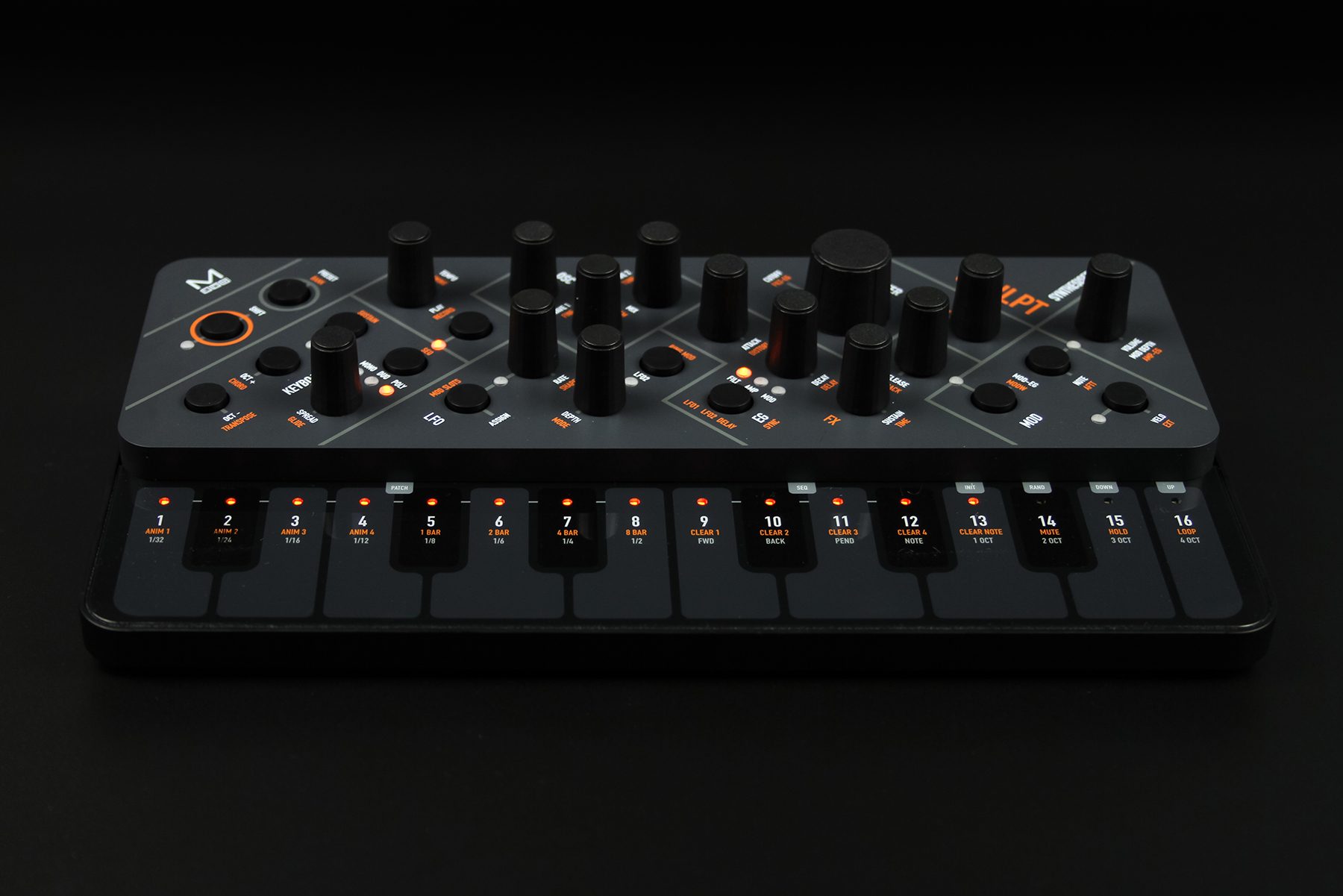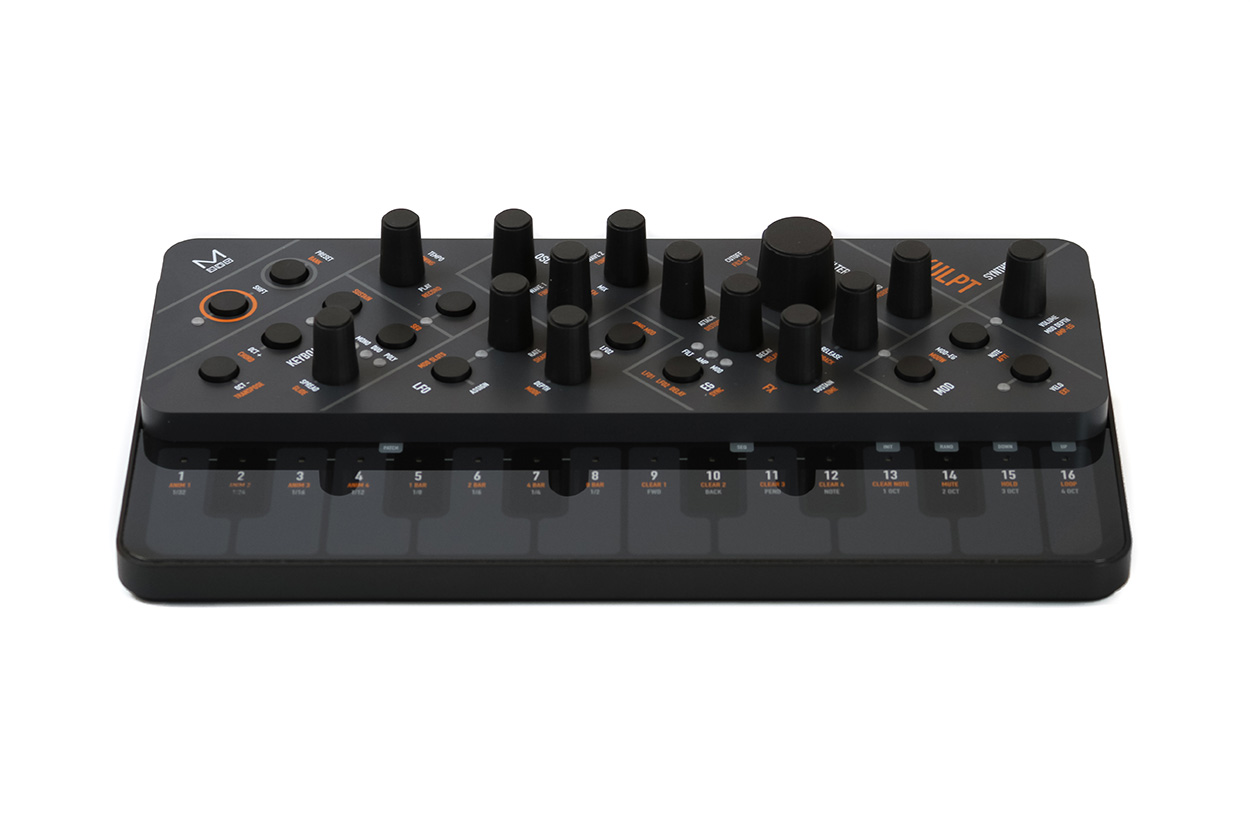
Review: Modal Skulpt
Modal Electronic’s Skulpt is a four-voice 32-oscillator synth that builds on the tradition of their Craft DSP synthesizer, bringing polyphonic capabilities and considerably more synthesis power to a package small enough to fit in your carry-on baggage.
Modal Electronics is renowned for its range of high-end boutique synthesizers, with the Modal 008 providing the most complete embodiment of features one could want in a modern polyphonic analogue synth. Skulpt is Modal’s polyphonic follow-up to their earlier low-cost DSP monophonic synth, Craft, which was a self-assembled kit. Craft’s pedigree and price garnered the curiosity of the synth community, and provided a taste of where Modal was headed with their DSP synth product line.
FIRST IMPRESSIONS
Upon unpacking the unit, it’s clear Modal shoe-horned substantial synthesizer power into a very lightweight and compact box. Its construction is unashamedly plastic (with the exception of the glass-like finish on its touch-keyboard) and its front-panel knobs are PCB mounted. The rather fragile micro-USB standard socket has been used for USB connectivity (providing USB MIDI only) and mini-jack sockets are provided for headphones, line out, and sync in/out connectors. To my surprise, Modal provides MIDI In/Out on full-size DIN sockets which is most welcome (albeit inconsistent considering miniature versions of other sockets are used elsewhere). There is no DC input or power supply included because the Skulpt is powered by USB bus power, or six AA batteries.
Inside the package you’ll find a stylish plastic covering lid, intended to protect the front panel controls when stuffed in a gig-bag. This cover also serves as a cradle for the unit, making it sit flat on your desktop if you don’t like its angled profile. A reference card of command shortcuts is also included.
An array of 16 touch-pads serves as a basic note on/off keyboard as well as being the means of selecting patches and executing secondary functions. For expressive playing, I suspect most users will play it from a controller keyboard with velocity and aftertouch – thankfully the synth engine responds to both. If anything, it’s a sound module with 16 built-in trigger pads that will be convenient for on-the-go sound design sessions.
In a welcome move, all front panel parameters are adjusted by rotary encoders with sensible degrees of acceleration. These also send MIDI CC data that is capable of being captured into a sequencer or used to control external hardware/software. When parameters are tweaked, an array of LEDs built into the keyboard light up to show the amount of adjustment being made – a nice touch that provides an immediate visual sense of the value range being tweaked.
The layout of the front panel is puzzling for the uninitiated. Rather than adopting a grid of parameters, they are rotated 45 degrees and grouped in strange ways that give the Skulpt an interesting design aesthetic at the expense of intuitive operation. Almost every control is labelled with two parameters; those printed in orange are secondary parameters/functions accessed with the Shift button. The Shift button is latching, rather than momentary, which took some getting used to. Quite often I’d tweak parameters forgetting to check if Shift mode was engaged or not, unintentionally changing parameters I didn’t want to.
Without reading the manual, I found getting to grips with this synth to be a challenge. It was with much relief that I discovered Modal’s fully featured Editor/Librarian app for iOS, MacOS, Windows and Android (see ‘Editor/Librarian App’).
NEED TO KNOW
Modal Skulpt
Virtual Analogue Synthesizer
VOICE STRUCTURE
A Skulpt voice consists of dual morphing waveform generators, Wave One and Wave Two, each having four stacks of virtual oscillators (thus eight oscillators per voice, and Skulpt has a total of 32 oscillators). Wave One morphs between Sine, Triangle, Saw, Square and PWM. Wave Two morphs between Sine, Triangle, Saw, Square, Noise and Low Pass Filter. A Mix control crossfades the output of Wave One versus Wave Two. For pitch control, I found it odd that there is no coarse adjustment setting for Wave One; only pitch offset for Wave Two is provided (a Detune control that snaps to musically useful intervals, and a fine Tune control). Although there is an Octave transpose function, it affects only the built-in keyboard rather than the pitch of notes incoming via MIDI.
Three Voice Assign modes are available: Mono (all 32 oscillators stacked), Duo (two voice polyphony, each with 16 oscillators stacked) and Poly (four voice polyphony, each with eight voices stacked). A flexible MIDI Poly Chain mode allows you to expand the polyphony with the addition of up to a further three units via the MIDI DIN connections.
With Spread at 0%, the oscillator stacks are phase-locked. Increasing Spread nudges the oscillators out of phase, gradually introducing detuning for the first 50% of the value range, with the oscillator stacks forming into various chord shapes for the remaining 50%. I found the Spread feature is best reserved for pads since it had a tendency to weaken the overall sound. I preferred the sound of the oscillator stacks in phase, particularly with Voice Assign in Mono mode (with 32 oscillators stacked) for really powerful, up-front sounds!
A basic FM function is provided that gives you some unique opportunities considering Noise is available within Wave Two. Ring Modulation is also on offer and can be used alongside FM simultaneously.
Skulpt has a single digital two-pole (12dB/Octave) state-variable filter with a continuous Morph control blending from Low Pass, Band Pass and High Pass. It exhibits characteristics similar to a ladder filter, whereby increased resonance reduces low frequencies. It’s a very musical filter with plenty of character, and its morphing feature is a very useful sound design component.
MODULATION SOURCES & MATRIX
Skulpt features three ADSR envelopes – one for the Filter, one for the Amplifier and one for Modulation (the latter being freely assignable). Each envelope stage may be up to four seconds in duration. The envelopes share one set of ADSR encoders on the front panel, with an ‘EG select’ button to select which envelope you’re adjusting. By pressing and holding the ‘EG select’ button, the ADSR encoders can adjust all three envelopes simultaneously.
Two LFOs are provided, with LFO1 being monophonic and LFO2 being polyphonic. Similar to the oscillators, both can morph between waveshapes including sine, triangle, sawtooth, square and sample-and-hold. Although both are capable of audio-rate speeds, LFO2 has a unique trick within: when not synced to clock, the 50-100% adjustment of the rate is connected to the fundamental root frequency of the note being played and thus goes into much higher audio rates with a harmonic relationship to the note being played, allowing you to add a nice growl to patches at extremes.
A flexible modulation matrix provides eight Mod slots with an enormous 37 destinations. Assignments can be rapidly established from the front panel, muted or cleared. The modulation matrix is without restriction except that polyphonic sources cannot be assigned to monophonic destinations.
With a synth having so much to offer in terms of modulation sources and the flexibility of the modulation matrix, it’s easy to come up with several original new patches in the course of a session.
EFFECTS
The effects section at least offers the basics. There is a waveshaping Distortion effect, prior to the filter, with a single control to increase its intensity. For my own tastes I found just a hint of distortion was enough, unless I wanted to completely decimate a sound. A tape delay effect is included which can be synced to incoming clock with three parameters available to tweak – rate, feedback and mix amount. All effects parameters are available as destinations in the modulation matrix.
ARPEGGIATOR/SEQUENCER
An Arpeggiator with the usual expected functionality is provided with control over type, note divisions, octave span and so forth. Skulpt also has a built-in 256 step sequencer. Sequences are not independent for each patch but, rather, draw from a pool of four banks of 16 sequences. Sequences may be up to eight bars in length and polyphonic. Sequences can be recorded in real-time, however a step recording mode is not available. Sequences can also be created by recording the results of the Arpeggiator if desired, and, during playback, you’re able to play over the top of the sequencer while it’s running.
Four Animation lanes are available in the sequencer which capture movement of any parameter into a sequence. Similar to other synths with this feature, you can exploit this to provide faux tempo-synced looped envelopes to complement its already powerful modulation matrix. Unfortunately there doesn’t appear to be a means of transposing the sequencer notes in real-time by playing the keyboard to follow chord progressions of a song.
CRITIQUE
With so many features crammed into a unit of such miniscule stature, navigation inevitably involves extensive use of modifier keys even for basic operation. In fact, without reading the manual or watching YouTube demos, I found Skulpt to be somewhat impenetrable. While on the topic of the manual, it provides a quick overall technical reference but fails to document many aspects of operating the synth.
Skulpt would benefit substantially from having a miniature display on board to show the patch name and digital readout of parameters as they’re adjusted. Naturally, this would add to the price but other recent similarly-specced four-voice synths do provide this convenience.
Unless Mono mode is engaged, I found the audio output of Skulpt to be quiet compared with other synths in my rig. As expected, Poly mode is significantly lower in output when compared with Mono mode, with no means to store a volume offset for each patch, to compensate for such variations. I often had to insert a preamp to boost the volume to acceptable levels when tracking into my DAW.
My biggest bug-bear is the use of a fragile micro-USB socket; these are notorious for lacking durability, and are difficult to repair. Considering this is the only way to power the synth, aside from batteries, I was puzzled as to why a full-size USB socket wasn’t used, instead.
CONCLUSIONS
With a synth having so much to offer in terms of modulation sources and the flexibility of the modulation matrix, it’s easy to come up with several original new patches in the course of a session. Having morph functions on the oscillator waveshapes, LFO waveshapes and filter curves is superb, and having these also available as modulation destinations is the icing on the cake. When played from a controller keyboard with aftertouch, mod and velocity, it’s possible to build highly expressive, interactive patches.
The sound of the unit is top class and, in particular, it excels at generating really solid, modern basses with plenty of subsonic presence, and sonically diverse leads and pads. Once you find its sweet spots and play to its strengths, you’ll be rewarded!
Although I have misgivings about the front-panel layout, these are more than compensated for by the included editor software and the depth of integration possible as a DAW plugin. The use of rotary encoders for all parameters was a smart choice considering the multi-functional nature of how parameters are distributed, and elevates its potential as a MIDI control surface for other hardware and software.
I’ve no doubt Modal will expand on the Skulpt concept in future iterations, perhaps providing a larger unit with eight or 16 voices, a built-in display and an expanded range of oscillator waveshapes. As it stands, it is a fantastic sounding synth that will be a hit with touring musicians seeking a compact and flexible hardware synth to stuff into their carry-on.





























RESPONSES